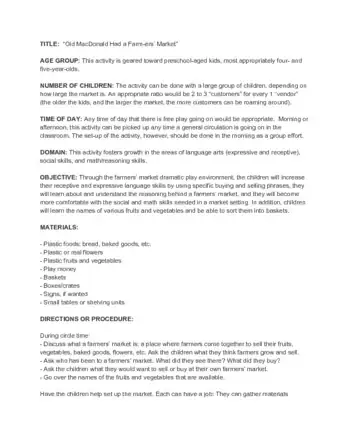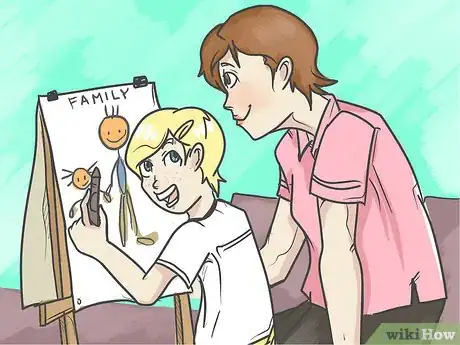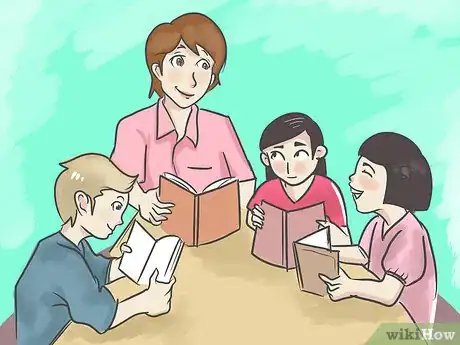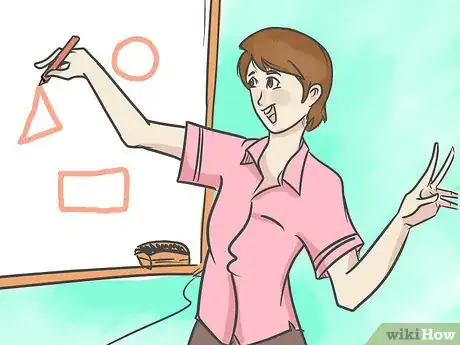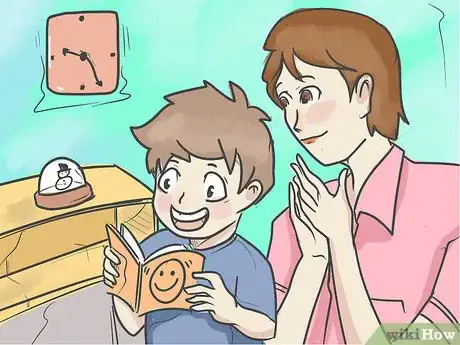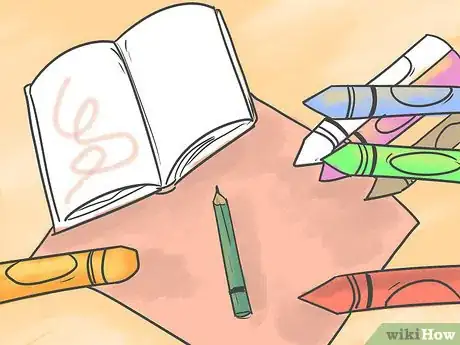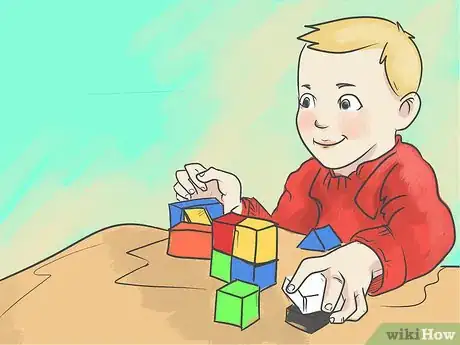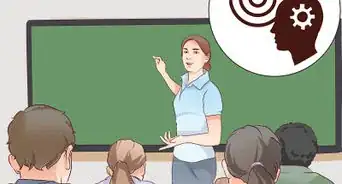This article was co-authored by Sylvia Rath. Sylvia Rath is a Parenting Specialist and the Director of Little Village Nursery School in Los Angeles, California. With over 30 years of experience, Sylvia guides parents through the preschool years and beyond by teaching respectful communication and positive discipline methods. Sylvia holds a BA in Psychology and Early Child Development from Antioch University. Before working at Little Village Nursery School, she taught preschool for eight years.
There are 12 references cited in this article, which can be found at the bottom of the page.
wikiHow marks an article as reader-approved once it receives enough positive feedback. In this case, several readers have written to tell us that this article was helpful to them, earning it our reader-approved status.
This article has been viewed 480,321 times.
Writing a preschool lesson plan takes time up front, but once you establish a template that works for you the process will become much easier. Thoughtfully created lesson plans will ensure children learn and have fun while meeting necessary learning benchmarks to prepare them for kindergarten. Preschool lesson planning is done in "big picture" and "small picture" segments. The "big picture" will help you make a cohesive plan for the entire semester or year. The "small picture" will help you make meaningful and engaging lessons within that broader plan.
Steps
Sample Lesson Plan
Planning the "Big Picture"
-
1Assess your students' skills. Before you start planning your lessons, establish your students' skill sets in communication, language awareness and reading readiness, number awareness and math readiness, gross and fine motor skills, and social and emotional development. Every child learns and develops at a different pace, and that’s okay! Rather than forcing them to engage in easier or harder lessons, plan around their skills to encourage them to grow.[1] Here are some things to keep in mind:[2]
- Design lesson plans by keeping in mind the specific user groups - Preschool lesson plans have to be specifically designed to give a proper look for each user groups.
- In draft stage itself, lesson shall be shared with each staff members
- Preschool children develop at different rates and have various levels of support in the home, so it should be no surprise that your students will likely display a wide variety of skills and readiness in various areas of development.
- Major areas to assess before the start of a semester include: verbal skills, phonological awareness, number awareness, fine and motor skill development
- The number of children you have and how much time you have for assessments will likely influence the type of assessment you conduct, but in general brief assessments (when you have 20 minutes per child or less) can be structured (at a desk with a teacher, using flashcards, using paper and pencil, etc.) while longer assessments should be more naturalistic (watching them at play centers, watching their interactions with peers, etc.). Young children don't have the patience or ability to sit for prolonged assessments.
- Various early childhood factors contribute to each child's skills. For example, it is not unusual for some 4 year old children to not yet know their alphabets; although more rare, others might already read at a 2nd or 3rd grade level.
- Identify students with delays, special needs, or giftedness. These students may require additional support throughout the semester, or additional effort to tailor lesson plans to their particular needs.
- Under law, all students are guaranteed reasonable accommodation for disabilities and developmental delays. Students with developmental delays or disabilities (including autism and learning disabilities such as ADHD) should be referred for evaluation with the district coordinator, who will conduct a specialized assessment that takes all areas of development into account and can put together an Individualized Education Plan (IEP) to ensure that children receive the services they need to thrive in preschool. This process can vary by state, so check with your site coordinator.[3]
-
2Create a calendar of the semester or school year. This can be done using a simple computer program, poster board, or even a notebook. By including start and end dates and holidays, you will get an overall picture of the plan for the preschool year.
- Label breaks and holidays and number each week of instruction. These numbers will correspond to your plans.
- Think about the big picture. What are the learning objectives for your students?
Advertisement -
3Choose a theme for each month, and focus areas for each week. A theme is a broad category, which you can think of as an ongoing topic of discussion or emphasis. A focus area is a subcategory of that theme, or a more particular instance to draw the children's attention to features of the theme.
- For instance, the Mississippi State University Early Childhood program suggests monthly units such as "All About Me," "The Community," "Food," "The Weather," etc. These units would each have weekly a focus area. For example, if the month's theme is "Food," the weeks might be divided into the focus areas "Breakfasts," "Lunches," "Dinners," and "Desserts." The focus areas will be further developed in daily lessons (in this case, each day might be devoted to the mealtime cuisine of a separate culture).
- Some teachers prefer to choose only a few themes and focus areas to begin with, and from there let the students' interests guide the development of the rest of the semester's themes.
-
4Locate or write your class's daily schedule. School day lengths vary for preschoolers, with some attending half days and some full days, so begin by writing out what time students arrive and leave and any other built-in daily activities (snack time, recess, lunch, etc.). This might look something like:
- 8-8:10am: Arrival, pledge of allegiance, roll
- 9-9:20am: Potty break, snack
- 10-10:20am: Outdoor recess
- 10:50: Gather backpacks and line up for home
-
5Segment the rest of the day into subject areas. These are the areas on which you will focus your individual lessons and activities. Keeping them the same from day to day while changing up the particular activity can help students develop a routine, which helps them feel secure and confident that they know what to expect each day.
- These might include oral language/sharing time, letter recognition/phonological awareness, fine motor centers, book time, number recognition and math readiness, small groups, etc.
- Remember to focus on all major areas of early learning, including emotional, social, physical, and cognitive development. These are each significant in school readiness, the major goal of preschool curricula.
-
6Arrange these subject areas in small blocks of time of about 10-20 minutes each, depending on the length of your school day. Preschoolers' attention spans are short, so changing the activity regularly is a must.[4] This will ensure that the students are able to focus on the activity at hand and meet their learning objective, and it will also help to ward off behavioral problems that can result from boredom. At this point, your schedule may look something like this:
- 8-8:10am: Arrival, pledge of allegiance, roll
- 8:10-8:30: Community circle
- 8:30-8:45: Phonological awareness
- 8:45-9: Free play in centers OR art
- 9-9:20: Potty break, snack
- 9:20-9:40: Reader's workshop
- 9:40-10: Math
- 10-10:20: Outdoor recess
- 10:20-10:40: Vocabulary
- 10:40-10:50: Community circle
- 10:50: Gather backpacks and line up for home
-
7Begin to fill in activities and lessons. Each activity or lesson should connect the theme, focus area, and subject area.
- For instance, your theme for the month might be "All About Me" and your focus area for the week might be "My Family."
- In this case, sharing time in the community circle might involve stating who is in your family, math might involve writing the number of family members, and art might involve a family portrait made of dried noodles and beans.
Planning the Lesson
-
1Identify your objective. The objective should target what you want your students to know or be able to do after a lesson plan has been implemented. Objectives can be skill-based, conceptual, or both.
- Skill-based objectives require that your students learn to do something new. Examples include: Draw a triangle, button a shirt independently, spell their name.
- Conceptual objectives require that your students understand a concept or grasp an idea. Examples include: Identify a triangle, describe the weather, share their feelings in circle time.
- Some objectives combine skills and concepts, like sounding out a word, which requires students to understand the relationship between letters and sounds (a concept) and to put them together verbally into a word (a skill).
-
2Consider the interests of your current students. Ask them about what they want to learn about, and keep an ongoing list to refer back to for ideas.[5]
- Students of all ages learn best when they are engaged in the subject at hand. Some students, particularly those with attention or behavioral problems, benefit from lessons structured specifically around their areas of interest.[6]
- Some common preschool interests include: animals, particularly baby animals; seasons and weather; dinosaurs; sea life; outer space; fairy tales; robots; dolls and domestic activities like cooking, cleaning, and keeping house.
- Preschoolers also often have favorite pop culture figures and imaginary characters, and while these vary, you can get a good idea by asking your students who their favorite singers, cartoon characters, or video game characters are, or by paying attention to who is on their backpack or character apparel.
-
3Choose your approach. This will vary depending on your objective, the skills of your students, and the interests of your students. You will also want to vary your approach from activity to activity and from day to day, to keep the interest of the students.[7] Approaches might include:
- Writing or tracing letters or numbers
- Painting, drawing, or other art
- Gross motor exercises or activities
- Books that are relevant to the theme for story time and for children to read independently
- Songs with or without motions
- Sorting and counting activities using small figures or toys, etc.
-
4Gather your materials. This might include paper, pencils, crayons, craft supplies, books, a tape player, or other items.
- Be sure to plan enough for every student, plus extras in case of mistakes or accidents.
-
5Implement the lesson. Keep an eye on the time, but also don't be afraid to go off script. Some of the best learning moments happen when teachers respond to their students' questions and interests, even if it diverts from the original plan.
- Be sure to make notes afterwards about what worked well and what did not. In future years, you can use these notes to reuse, rewrite, or scrap plans depending on how well they worked during implementation.
Keeping Lessons Fun
-
1Remember that the most developmentally appropriate way for small children to learn is through play. Preschool lessons should be fun, engaging, and should involve a variety of senses and skills. In general, activities that involve rote memorization or repetition will be less interesting to preschoolers than similar activities.
- Spend lots of unstructured time on the playground. While these might not seem like "lessons" in the traditional sense of the word, researchers have found that free play shapes development of the prefrontal cortex during a critical period of early childhood, which has lifelong implications for emotional regulation, planning, and problem solving.[15]
-
2Build a classroom around the idea of play. Centers in the classroom should be designed to encourage imaginative, cooperative play.[16] This can encourage role playing, turn taking, and cooperation with peers. This can increase students interpersonal skills and self-confidence.[17]
- Consider a center designed to mimic a playhouse, with a kitchen set, small toddler-sized table and chairs, baby dolls and bassinet, etc. Small, affordable toys from stores like Ikea or second hand shops can make this very affordable.
- Create a costume wardrobe. This can range from fancy costumes to simple silk scarves. You can often find costumes on sale right after Halloween, or simply bring creative clothing from a second hand store like overalls, a fancy princess dress, a cowboy hat, any type of uniform, etc.
- Plush stuffed animal toys are often the beginning of many creative games for preschoolers. Children can use their imagination to pretend that these are students in a classroom, pets in a home, animals in a rescue center or veterinary clinic, etc. Choose toys that you can easily wash every few months in a washing machine.
-
3Build in adult interaction. This can often be difficult in large classes, but find a way to spend time with each child either daily or weekly, engaging in a small game or one-on-one reading time. Studies show that adult interaction is crucial for developing confidence and early literacy skills. It also reinforces the student-teacher bond which makes a child feel safer and more secure in school.[18]
- In addition to one-on-one time, consider inviting parent volunteers to read to children once a week in small groups. The number of volunteers you get can determine the size of the groups; anything from one-on-one to groups of five students per adult will foster relationships and discussion that are key to early literacy.
Expert Q&A
-
QuestionWhy is it necessary to include movement in the class?
 Courtney CoprivizaCourtney Copriviza is an Elementary School Teacher based in Maui, HI. Courtney specializes in elementary education, classroom management, and social and emotional development. She holds a BA in Communication with a minor in Urban Education and an MA in Teaching from Santa Clara University. Courtney has also taught high school in Madrid, Spain. She is a member of Kappa Delta Pi International Honors Society in Education.
Courtney CoprivizaCourtney Copriviza is an Elementary School Teacher based in Maui, HI. Courtney specializes in elementary education, classroom management, and social and emotional development. She holds a BA in Communication with a minor in Urban Education and an MA in Teaching from Santa Clara University. Courtney has also taught high school in Madrid, Spain. She is a member of Kappa Delta Pi International Honors Society in Education.
Elementary School Teacher Movement is necessary for younger elementary students because they cannot remain seated for a long time in the same place.
Movement is necessary for younger elementary students because they cannot remain seated for a long time in the same place. -
QuestionHow can I build a relationship with my students?
 Courtney CoprivizaCourtney Copriviza is an Elementary School Teacher based in Maui, HI. Courtney specializes in elementary education, classroom management, and social and emotional development. She holds a BA in Communication with a minor in Urban Education and an MA in Teaching from Santa Clara University. Courtney has also taught high school in Madrid, Spain. She is a member of Kappa Delta Pi International Honors Society in Education.
Courtney CoprivizaCourtney Copriviza is an Elementary School Teacher based in Maui, HI. Courtney specializes in elementary education, classroom management, and social and emotional development. She holds a BA in Communication with a minor in Urban Education and an MA in Teaching from Santa Clara University. Courtney has also taught high school in Madrid, Spain. She is a member of Kappa Delta Pi International Honors Society in Education.
Elementary School Teacher To build a relationship with your students, you should be genuinely interested in what they want to say. Ask questions and give them time to speak instead of speaking yourself all the time.
To build a relationship with your students, you should be genuinely interested in what they want to say. Ask questions and give them time to speak instead of speaking yourself all the time. -
QuestionHow can I keep the class calm?
 Courtney CoprivizaCourtney Copriviza is an Elementary School Teacher based in Maui, HI. Courtney specializes in elementary education, classroom management, and social and emotional development. She holds a BA in Communication with a minor in Urban Education and an MA in Teaching from Santa Clara University. Courtney has also taught high school in Madrid, Spain. She is a member of Kappa Delta Pi International Honors Society in Education.
Courtney CoprivizaCourtney Copriviza is an Elementary School Teacher based in Maui, HI. Courtney specializes in elementary education, classroom management, and social and emotional development. She holds a BA in Communication with a minor in Urban Education and an MA in Teaching from Santa Clara University. Courtney has also taught high school in Madrid, Spain. She is a member of Kappa Delta Pi International Honors Society in Education.
Elementary School Teacher If the students are getting off task and the class is becoming noisy, you can use calm response techniques. You can make them do 123 eyes on me 123 eyes on you, or ask them to make a waterfall sound. The children like them and know they need to be quiet after doing them.
If the students are getting off task and the class is becoming noisy, you can use calm response techniques. You can make them do 123 eyes on me 123 eyes on you, or ask them to make a waterfall sound. The children like them and know they need to be quiet after doing them.
References
- ↑ Sylvia Rath. Parenting Specialist. Expert Interview. 19 May 2021.
- ↑ http://www.leapfrog.com/en-us/learning-path/articles/preschool-skills-checklist
- ↑ http://oklaw.org/resource/what-is-an-iep-individualized-education-progr?ref=jGAGu
- ↑ Courtney Copriviza. Elementary School Teacher. Expert Interview. 18 June 2021.
- ↑ Courtney Copriviza. Elementary School Teacher. Expert Interview. 18 June 2021.
- ↑ https://www.helpguide.org/articles/add-adhd/teaching-students-with-adhd-attention-deficit-disorder.htm
- ↑ Courtney Copriviza. Elementary School Teacher. Expert Interview. 18 June 2021.
- ↑ http://fcd-us.org/sites/default/files/DualLanguageLearners.pdf
- ↑ https://www.childrensmn.org/services/care-specialties-departments/physical-rehabilitation/receptive-and-expressive-language/
- ↑ https://www.ncbi.nlm.nih.gov/pmc/articles/PMC5659623/
- ↑ http://www.aft.org/sites/default/files/t2k_schoolreadiness.pdf
- ↑ http://www.aft.org/sites/default/files/t2k_schoolreadiness.pdf
- ↑ http://www.aft.org/sites/default/files/t2k_schoolreadiness.pdf
- ↑ http://www.aft.org/sites/default/files/t2k_schoolreadiness.pdf
- ↑ http://www.npr.org/sections/ed/2014/08/06/336361277/scientists-say-childs-play-helps-build-a-better-brain
- ↑ Courtney Copriviza. Elementary School Teacher. Expert Interview. 18 June 2021.
- ↑ http://www.urbanchildinstitute.org/articles/research-to-policy/overviews/play-supports-early-brain-development-in-impressive-ways
- ↑ https://ecampusontario.pressbooks.pub/educ5202/chapter/the-importance-of-student-teacher-relationships/
About This Article
Before writing a preschool lesson plan, first identify what it is you want the children to learn from the lesson, like a specific new skill or identifying a concept like shape identification. Next, think about what your students are interested in, such as animals, fairy tales, or cartoon characters. Then, incorporate those things into the lesson through art projects, songs, or gross motor activities. Gather any materials you might need and then present the lesson to the students, staying flexible and responding to their questions. If you want to learn how to create a schedule for your preschool class, keep reading the article!
